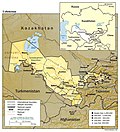Search results
Appearance
There is a page named "Agriculture in Uzbekistan" on Wikipedia
- Agriculture in Uzbekistan employs 28% of the country's labor force and contributes 24% of its GDP (2006 data). Crop agriculture requires irrigation and...9 KB (1,145 words) - 00:30, 1 August 2024
- Uzbekistan that it predicted agriculture as playing a major component of the country's economic development in the future. Agriculture in Uzbekistan employs...57 KB (5,641 words) - 14:18, 4 September 2024
- production in Uzbekistan is important to the national economy of the country. It is Uzbekistan's main cash crop, accounting for 17% of its exports in 2006....19 KB (2,209 words) - 04:17, 30 August 2024
- Uzbekistan, officially the Republic of Uzbekistan, is a doubly landlocked country located in Central Asia. It is surrounded by five countries: Kazakhstan...178 KB (15,699 words) - 06:12, 5 September 2024
- of Agriculture of the Republic of Uzbekistan (Uzbek: O'zbekiston Respublikasi Qishlоq хo'jаligi vazirligi) is a government administration body in Uzbekistan...2 KB (61 words) - 18:46, 9 July 2022
- Uzbekistan is a country in Central Asia, located north of Turkmenistan and Afghanistan. With an area of approximately 447,000 square kilometers, Uzbekistan...36 KB (3,504 words) - 23:12, 30 August 2024
- The Uzbek cotton scandal, also known simply as the cotton scandal (Russian: хлопковое дело, Uzbek: paxta ishi) or the Uzbek scandal (Russian: Узбекское...18 KB (2,047 words) - 21:24, 20 July 2024
- Dehkan farm (category Agriculture in Uzbekistan)the few remaining shirkats (former collective farms). All agricultural land in Uzbekistan is owned by the state. While this situation allows the state...4 KB (460 words) - 07:04, 17 May 2024
- agriculture, and the greater relative worth of Soviet child benefits in Uzbekistan. Abortion was the preferred method of birth control. Legalized in 1955...74 KB (3,066 words) - 16:10, 25 July 2024
- a list of notable Uzbek dishes and foods. Uzbek cuisine is the cuisine of Uzbekistan. The cuisine is influenced by local agriculture such as grain farming...7 KB (691 words) - 18:22, 29 August 2024
- Uzbekistan is a landlocked country in Central Asia. It is itself surrounded by five landlocked countries: Kazakhstan to the north; Kyrgyzstan to the northeast;...69 KB (8,944 words) - 21:09, 29 August 2024
- Kalmyk cattle (category Agriculture in Uzbekistan)documented in the Global Databank for Animal Genetic Resources, annex to The State of the World's Animal Genetic Resources for Food and Agriculture. Rome:...5 KB (384 words) - 21:45, 13 August 2023
- in Uzbekistan Uzbekistan at the Olympics Economy of Uzbekistan Economic rank, by nominal GDP (2007): 87th (eighty-seventh) Agriculture in Uzbekistan Banking...13 KB (776 words) - 23:13, 30 August 2024
- Tajikistan Agriculture in Turkmenistan Agriculture in Uzbekistan Agriculture in Afghanistan Z. Lerman and I. Stanchin, "Agrarian reforms in Turkmenistan", in: S...5 KB (625 words) - 06:17, 6 August 2023
- The Uzbek Soviet Socialist Republic (US: /ʊzˈbɛkɪstæn, -stɑːn/ , UK: /ʊzˌbɛkɪˈstɑːn, ʌz-, -ˈstæn/), also known as Soviet Uzbekistan, the Uzbek SSR, UzSSR...22 KB (1,744 words) - 06:08, 6 September 2024
- This is a list of universities in Uzbekistan. Andijan Agriculture Institute Andijan Machine-Building Institute Andijan State Medical Institute Andijan...6 KB (490 words) - 22:35, 29 August 2024
- An agriculture ministry (also called an) agriculture department, agriculture board, agriculture council, or agriculture agency, or ministry of rural development)...23 KB (187 words) - 21:48, 29 August 2024
- Surxondaryo Region (category Regions of Uzbekistan)Republic of Uzbekistan" (in Uzbek and Russian). The State Committee of the Republic of Uzbekistan on statistics. July 2020. Agriculture in Uzbekistan, State...12 KB (840 words) - 11:58, 20 August 2024
- Tashkent (redirect from Tashkent, Uzbekistan)Tashkent (/tæʃˈkɛnt/), or Toshkent in Uzbek, is the capital and largest city of Uzbekistan. It is the most populous city in Central Asia, with a population...75 KB (6,846 words) - 14:38, 4 September 2024
- of Greater Iran. Iran and Uzbekistan have signed bilateral agreements to cooperate in various fields including, agriculture, transport, oil and gas production...3 KB (301 words) - 11:16, 1 August 2024
- CIA World Fact Book, 2004 Uzbekistan 8160CIA World Fact Book, 2004 — Uzbekistan This page was last updated on 1 January 2003 This is a snapshot of the
- fertilisers. This led to an increase of birth defects among Uzbek and Turkmen children. The children living in eastern Kazakhstan were afflicted with such horrors
- be found with the Aral Sea which lays across the Kazakhstan and Uzbekistan border in Asia. The Aral Sea used to be the fourth largest lake on Earth, covering














